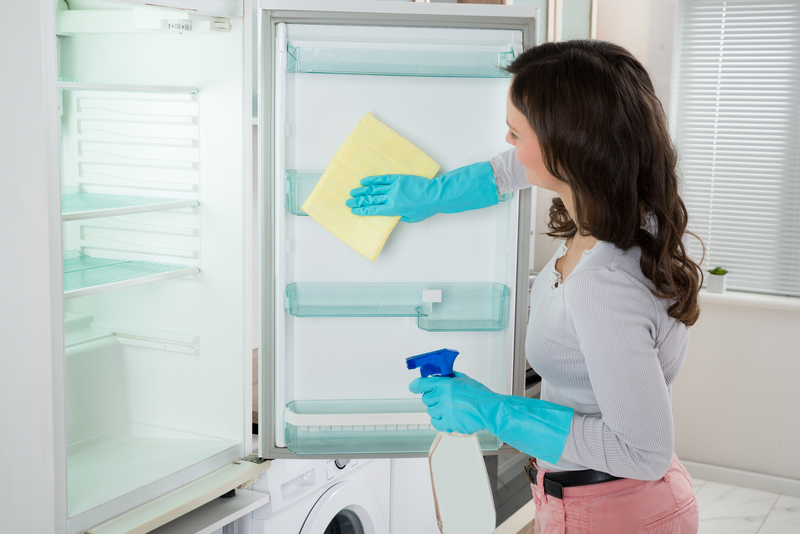Ensuring Mold-Free Window Sills: A Step-by-Step Approach
Posted on 12/09/2025
Ensuring Mold-Free Window Sills: A Step-by-Step Approach
Are you struggling with persistent mold on window sills? Mold isn't just an eyesore--it poses health risks and can significantly decrease your home's value. If you're on a quest to maintain fresh, mold-free window sills, look no further. This comprehensive guide offers everything you need to know, packed with step-by-step solutions, preventions, and maintenance advice for eliminating mold and keeping your windows healthy year-round.
Understanding Mold Growth on Window Sills
Mold is a type of fungus that thrives in damp, humid conditions. Window sills are especially prone to mold due to condensation, poor ventilation, and neglected cleaning. It's important to keep your window sill mold-free to ensure a healthy living environment, free of allergens and unsightly grime.
What Causes Mold on Window Sills?
- Condensation: Moisture from the air collects on cold surfaces, leading to a perfect breeding ground for mold.
- Poor Air Circulation: Without proper airflow, dampness lingers, accelerating mold growth.
- Leaks: Rainwater seeping through cracks or poorly sealed windows creates ideal mold conditions.
- Organic Matter: Dirt, dust, and decaying organic material on sills supply nutrients for mold spores.
Risks Associated with Moldy Window Sills
- Health Problems: Mold spores can trigger allergies, asthma, and respiratory infections.
- Structural Damage: Untreated mold can weaken wood, drywall, or plaster around window areas.
- Decreased Home Value: Mold decreases curb appeal and may deter prospective buyers.

Step-by-Step Mold Removal From Window Sills
If you've noticed black, green, or gray patches--don't panic. Removing mold from window sills is manageable with the right technique and consistency. Follow these actionable steps:
1. Gather Mold Removal Supplies
- Rubber gloves and protective eyewear
- Face mask (preferably N95)
- Old towels or rags for cleaning
- Spray bottle filled with a cleaning solution (see below options)
- Soft-bristle brush or sponge
- Paper towels or disposable cloths
- Garbage bag
2. Prepare a Mold-Busting Solution
- White Vinegar: Naturally kills 82% of mold species. Spray undiluted vinegar on affected areas.
- Hydrogen Peroxide (3%): Spray liberally and let it fizz for 10 minutes before wiping.
- Baking Soda Solution: Mix water and baking soda for gentle scrubbing of delicate surfaces.
- Commercial Mold Cleaners: Use as per manufacturer's instructions.
3. Apply the Cleaning Solution
- Spray the solution onto the moldy window sill. Make sure the entire area is covered.
- Let it soak for 5-10 minutes to break down mold colonies.
4. Scrub Off the Mold
- Use the soft-bristle brush or sponge to gently scrub the surface.
- For stubborn mold, repeat the spray-and-scrub process.
5. Wipe Clean and Dry
- Use disposable cloths or paper towels to wipe away the mold residue.
- Dispose of all used cleaning materials in a sealed garbage bag immediately.
- Completely dry the sill with a fresh towel to discourage further mold growth.
6. Inspect and Repeat if Necessary
- Repeat the cleaning process if visible mold remains.
- Stains that don't disappear may require refinishing or repainting the window sill.
Preventing Mold on Window Sills: Proactive Strategies
A truly mold-free window sill approach involves more than just removal--it's about prevention. These step-by-step tips keep mold off window sills in the long run:
Improve Indoor Ventilation
- Open windows regularly to allow fresh air circulation.
- Install exhaust fans in high-humidity areas, such as bathrooms and kitchens.
- Use ceiling or portable fans to keep air moving near windows.
Control Indoor Humidity
- Keep home humidity below 60%. Ideally, aim for 30-50% humidity.
- Use a dehumidifier during damp or rainy seasons.
- Repair plumbing leaks and dry spills promptly.
Enhance Window Insulation and Sealing
- Seal gaps and cracks around windows with caulking or weatherstripping.
- Upgrade to double-glazed windows if possible to minimize condensation.
- Check for signs of rot or water damage seasonally.
Regular Cleaning and Maintenance
- Dust and wipe down window sills weekly with a damp cloth.
- Clean away dead bugs, fallen leaves, and organic debris promptly.
- If you notice condensed water, wipe it up each morning during colder months.
Use Mold-Inhibiting Products
- Apply a mold-resistant primer or paint to window sills during home improvement projects.
- Look for window cleaning sprays with mildew-resistant additives.
Monitor Window Treatments
- Avoid heavy curtains that restrict airflow--opt for light, washable blinds.
- Regularly wash or replace window coverings to prevent hidden mold buildup.
Addressing Persistent Mold Issues
Some mold situations may demand extra attention, especially if you discover severe infestations, recurring mold, or structural damage. In these situations:
- Contact a professional mold remediation service if you suspect the mold has spread inside the wall, floor, or insulation.
- Have an inspector assess for hidden leaks, poor ventilation, or deeper water damage around windows.
- Replace or repair window casings, sills, or drywall if they show significant mold damage or rot.
Energy Efficiency and Mold-Free Windows
A well-sealed, energy-efficient home not only saves on utility costs but also helps keep window sills mildew-free. Energy-efficient windows curb condensation, and proper insulation minimizes the risk of cold spots and mold growth.
- Upgrade to Energy Star-certified windows.
- Install insulated window panels or storm windows for additional protection.
- Regularly check weatherstripping for signs of wear and replace as needed.

FAQs About Mold-Free Window Sills
1. How can I tell if the mold on my window sill is dangerous?
Most common household molds are not immediately hazardous but can aggravate health issues with prolonged exposure. If you notice musty odors, worsening allergies, or black mold (stachybotrys chartarum), consult a professional for remediation.
2. What's the most effective natural solution for mold removal?
Undiluted white vinegar is highly effective for most types of window sill mold. For best results, let it sit before scrubbing and repeat as needed.
3. How often should I clean my window sills to prevent mold?
For truly mold-proof window sills, wipe down and inspect sills weekly, especially in damp seasons or in rooms prone to condensation.
4. Can painting my window sills prevent future mold?
Yes! Using a mold-resistant paint or primer adds a protective layer, especially after thorough cleaning and drying. This preventive measure works best if underlying moisture issues are also addressed.
5. Why does mold keep returning to my window sills?
Frequent recurrence signals unaddressed moisture problems--often from leaks, poor ventilation, or high indoor humidity. Follow the preventive strategies in this guide to tackle root issues as well as symptoms.
Conclusion: Enjoying Clean, Healthy Window Sills Year-Round
With the right approach, ensuring mold-free window sills is entirely within reach. Regular inspection, prompt cleaning, and strategic prevention are keys to success. Don't let mold downgrade your comfort, air quality, or property value--take proactive measures and enjoy spotless, inviting window sills every season.
A commitment to thorough window sill mold prevention benefits your home and well-being for years to come.




